How to Catch Yellow Perch: Complete Guide to Techniques, Gear, and Locations
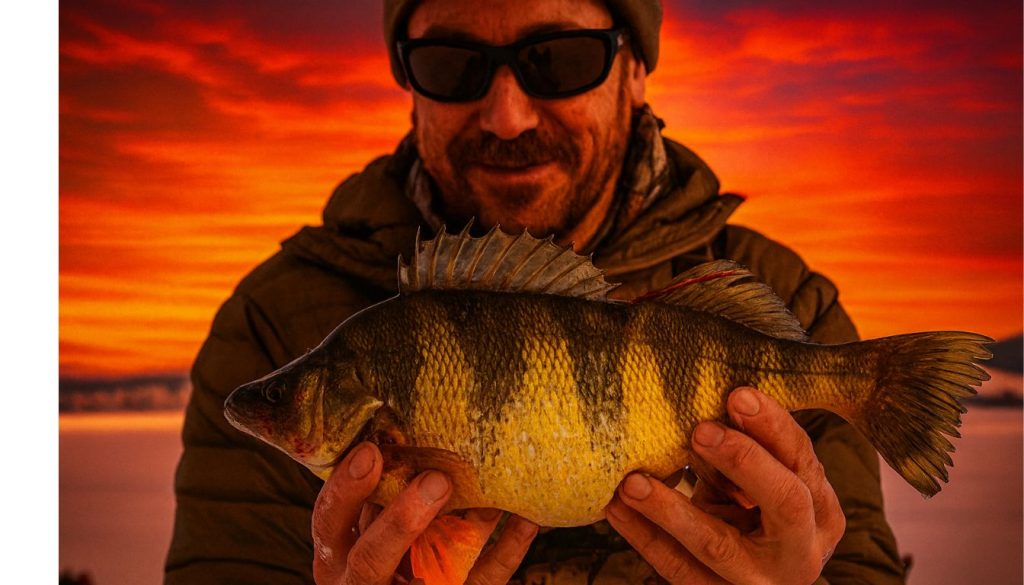
Species Profile
Quick Identification
Yellow perch (Perca flavescens) are a small freshwater perch native to much of the USA. They go by many common names including yellow perch, lake perch, striped perch, ringed perch, and American perch.
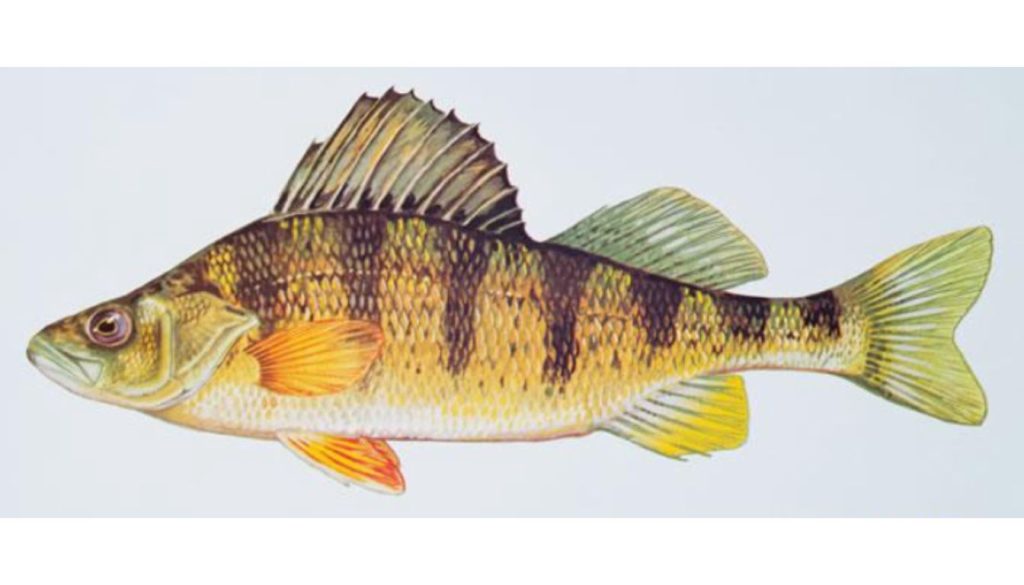
Adults have a golden-yellow body with 6–8 broad dark vertical bars on each side, and two dorsal fins (the first spiny, the second soft). Their fins often have an orange tint, especially in males during spawning season.
Yellow perch typically run 7–10 inches long in most waters, though in prime lakes mature fish can reach 10–14 inches (25–35 cm). Record specimens push the limits – the world record perch is 4 lb 3 oz (caught in 1865, ~1.9 kg), and the longest reported length is about 19.7 inches (50 cm).
Why Target This Species
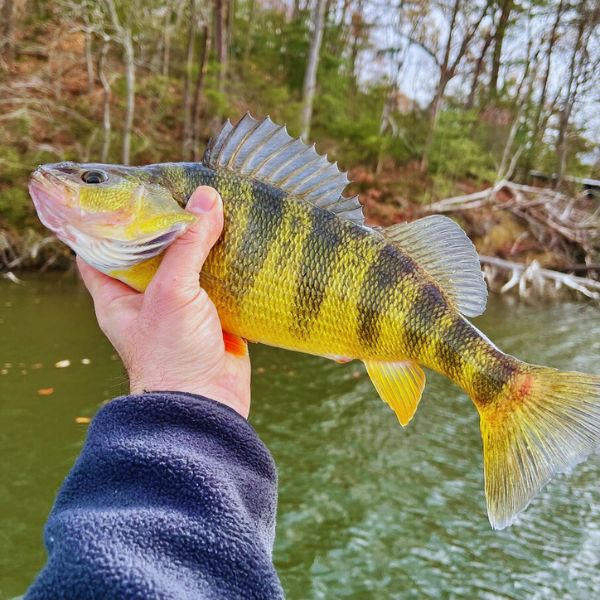
Yellow perch are considered beginner-friendly gamefish. They are very abundant and easy to catch – often schooling near shore – making them a great “people’s fish” for families and novice anglers.
Yet they are also prized by more serious anglers for their delicious white meat: the flesh is firm, flaky and sweet with a mild flavor. Perch fishing can be both fun sport and a source of fresh table fare.
The best time of year to target yellow perch is in the spring run and fall. During early spring (as soon as open water lets up), perch pack into shallow bays and tributaries to spawn, offering fast action. Likewise, in autumn cooler temperatures bring active schools back into shallower water.
In contrast, midsummer warm-ups often push perch deeper (cooler) where they are less accessible. Overall, spring and fall fishing for perch is typically most productive.
Behavior and Feeding
Hunting Pattern
Yellow perch are active daytime feeders that form noticeable schools. In midmorning and late afternoon they aggressively cruise and forage; most bites occur in low-light hours.
Perch are not ambush predators – instead they swim slowly along bottom and midwater picking off food. Juveniles often feed by straining plankton and tiny invertebrates from the water; adults forage the bottom, “nibbling” on prey.
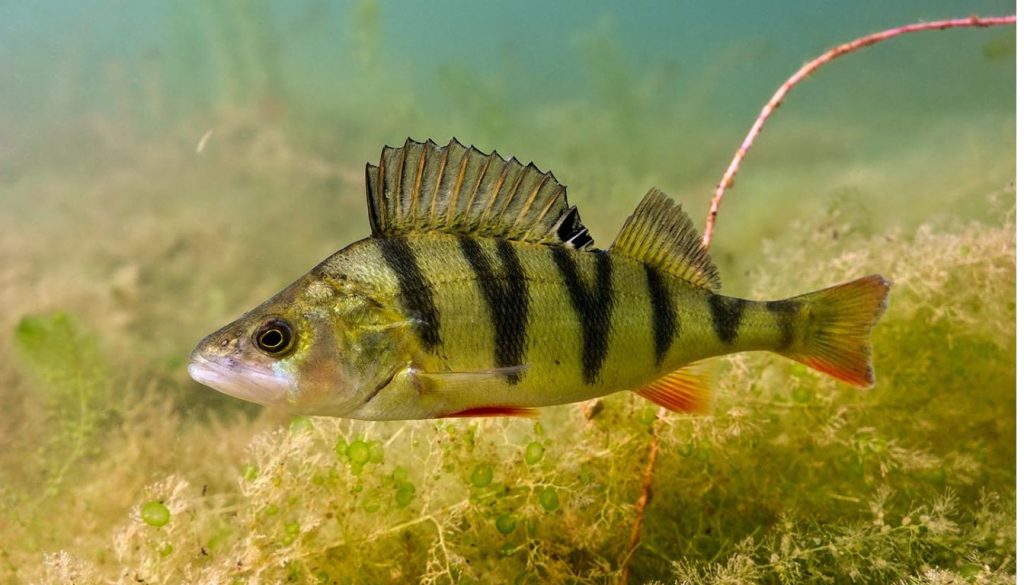
When feeding, perch are cautious biters, often stealing bait gently – anglers must watch rod tips or floats carefully for subtle strikes. Generally perch are highly schooling: where one is found, dozens more likely lurk nearby.
At night perch tend to disperse to deep cover, then regroup in the morning.
Primary Diet
Yellow perch have a broad diet that shifts with age and season. Young perch eat mostly zooplankton and small invertebrates, while larger perch consume a higher proportion of fish and crustaceans.
Yellow Perch Diet Guide
Understanding feeding patterns for successful angling
🍽️ Dietary Overview
Young Perch
Larger Perch
📅 Seasonal Feeding Patterns
🦐 Primary Food Items
🎯 Natural Bait Selection
🎣 Artificial Lure Strategies
Typical food items include aquatic insects (mayfly larvae, midges, dragonflies), small shrimp and amphipods, young crayfish, and minnows. In spring, perch in spawning areas gorge on the abundant zooplankton and insect hatch; in summer they add small fish and crawfish to their diet; in fall they focus on baitfish schools.
Because they eat both insects and small fish, effective baits mimic these prey: live minnows or worms are a top choice, as are jigs or spoons tipped with maggots, grubs, or small plastics. In practice, using bait or lures that imitate minnows, leeches or insect larvae works well for perch.
Where and When to Find Them
Key Habitat
Yellow perch inhabit a wide range of freshwater habitats throughout the northern half of the USA. They favor lakes, ponds, and slow-moving rivers with clear, moderately vegetated water.
Prime underwater structure includes weed beds, submerged brush or wood debris, drop-offs, and transition zones from soft to hard bottom. In spring and fall perch often patrol shallow bays and shallows with vegetation. In summer and winter they move to deeper water – often 10–30 feet down in lakes – near thermoclines or deep drop-offs, where cooler water concentrates them.
Across the USA, some hotspots include the Great Lakes (Erie, Michigan, Huron), midwestern lakes (Minnesota, Wisconsin, Michigan inland lakes), northeastern lakes (Finger Lakes, Adirondack ponds), and East Coast tidal rivers/tributaries (Chesapeake Bay tributaries).
Wherever perch are present, fishermen find them around cover and structure edges such as piers, docks, and shore drop-offs.
Fishing Calendar
Seasonal migration follows a pattern: perch move inshore to spawn in spring, offshore as water warms, and back in as temperatures cool. Optimal water temperature for perch activity is roughly 65–75°F; fish begin spawning around 45–52°F. Knowing local spawn timing or temperature can help pick the best weeks.
Optimal Conditions
Yellow perch bite best under stable weather and water conditions. They are a freshwater species, so tides are not a factor in most lakes – instead focus on atmospheric conditions. Barometric pressure stability tends to help; avoid sudden cold fronts or storms which can make perch sluggish.
Perch often feed throughout daylight, but many anglers report prime feeding at dawn and dusk. Overcast days can also improve light penetration and bite response. In spring, slightly stained water (from warming runoff) can concentrate perch and trigger feeding.
In short, calm, cool weather after a steady week of conditions often yields the best perch action.
Gear and Techniques
Recommended Setup
Primary Gear: Use a light or ultralight spinning outfit. A spinning rod around 6½–7 feet long, rated medium-light action, provides both casting distance and enough backbone to handle bigger perch. Pair it with a small spinning reel (5:1 or higher gear ratio) and 4–8 lb line (fluorocarbon or mono for invisibility, or fine braid for sensitivity). Anglers often add a 6–8 lb fluorocarbon or clear mono leader for stealth. This lightweight setup allows you to feel delicate bites and fight even 2-pound perch without overwhelming the fish.
Alternative Gear: In heavy cover or for trophy-sized perch (14–17 inches), step up to a medium-light rod with 8–12 lb line for extra power. A fast tip rod helps set hooks quickly if perch nibble softly. In open, shallow water or ice fishing, an ultralight ice rod and reel spooled with 2–4 lb line (with fluorocarbon leader) can improve bite detection on tiny jigs. Always carry sharp needle-nose pliers and a fine hook file or scaler – perch have sharp gill plates and spines.
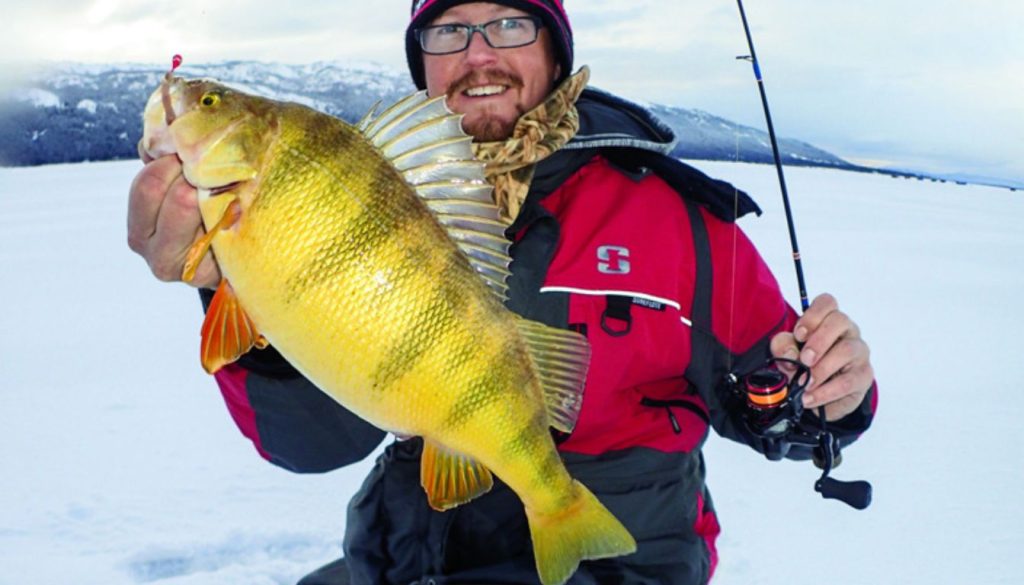
Effective Baits and Lures
Top 3 Natural Baits:
- Minnows (fathead, shiner, golden shiner) – Thread a 2″ minnow on a size #8–12 hook and suspend it under a small slip-float or cast it on a light jig. Rig the hook through the lips or back of the head so the minnow swims naturally.
- Nightcrawlers/Worms – Cut worms (red worms or nightcrawlers) into 1–2″ pieces. Mount on a No. 6–8 short-shank hook with a tiny sinker above or on a jighead. Worm segments can be worm-coated on jigs or used on a split-shot rig under a float.
- Maggots/Bloodworms – Tiny maggots, insect larvae (bloodworms), or small grubs on a tiny jighead or pin-hook will fool picky perch. These work especially well on an ice-fishing jig or under a feeder. Freshly-thawed waxworms can be equally effective.
Each bait should be presented on a small hook (size 8–12) or light jighead (1/32–1/8 oz) to match perch’s mouth size. Use a float rig (bobber) or light split-shot for minnows and worms so they can swim naturally. On jigs, a few slow twitches or gentle drifts down entice bites.
Essential Lures:
- Micro Jigs and Soft Plastics – 1″–2″ tube jigs, curly-tail grubs or twister tail soft baits on a 1/16–1/8 oz jighead are staples. Finesse them with lifts and drops around structure or let them drift by underwater cover.
- Small Spoons (Wobblers) – Lightweight spoons (½–1 g) work wonders, especially when jigged vertically or cast and retrieved in open water. Colors like silver/white, chartreuse, or perch-pattern (yellow with dark bars) are productive. Spoons excel when perch are deep and schooling.
- Inline Spinners (Rooster Tails) – Tiny spinnerbaits (with ½–2 g blades) are great in current or when casting along weed edges. The flash and vibration attract perch. Use 1/16–1/8 oz models with 1″ white, yellow, or chartreuse blades.
- Mini Crankbaits/Blade Baits – Very small crankbaits (1–2″) that mimic minnows, or rectangular blade baits on a minnow harness, can trigger aggressive strikes, especially in cooler deeper water.
Rotate lure colors and retrieves by depth and water clarity: in murky water, go bright (chartreuse/white); in clear water, natural or silver hues perform best.
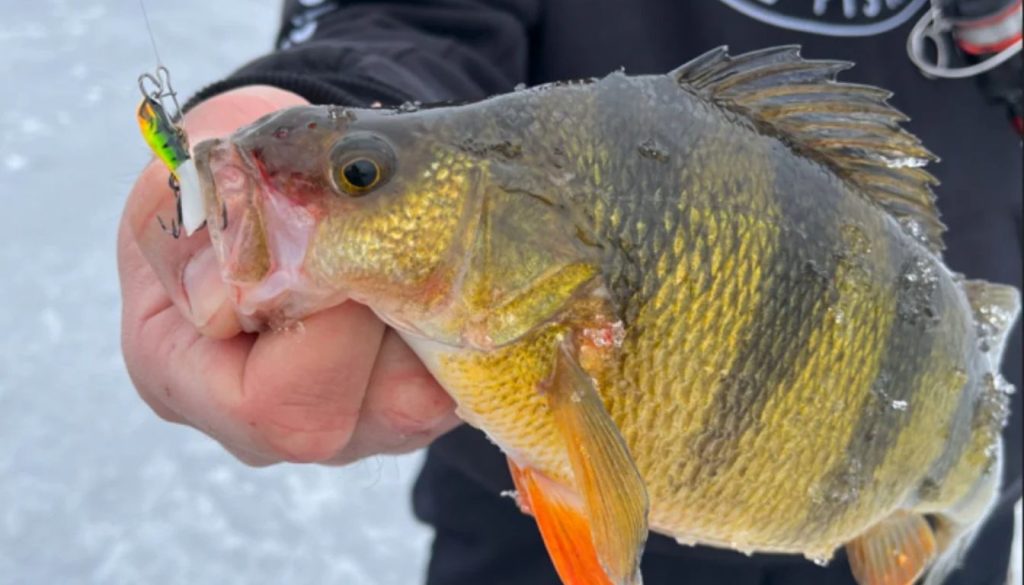
Fishing Techniques
Main Technique (Jigging/Float-Fishing): One of the most effective methods is a slip-float or bottom-rig with a small baited hook, or directly jigging with a light lure. For a float rig, slide a small split-shot or slip-sinker 12″ above a size 8–10 hook rigged with a minnow or worm. Cast just past cover and let the bait hang at a few feet depth. Keep the line tight and watch the float – any twitch or submergence is likely a perch. Set the hook firmly but gently.
For jigging, drop a 1/16–1/8 oz jig (with plastic grub or live bait) to the bottom near drop-offs or weed edges, then lift your rod tip 1–2 feet and let the jig fall. Twitch the jig occasionally to impart action. This “lift-and-fall” imitates fleeing prey and often induces perch strikes. Repeat across likely depths.
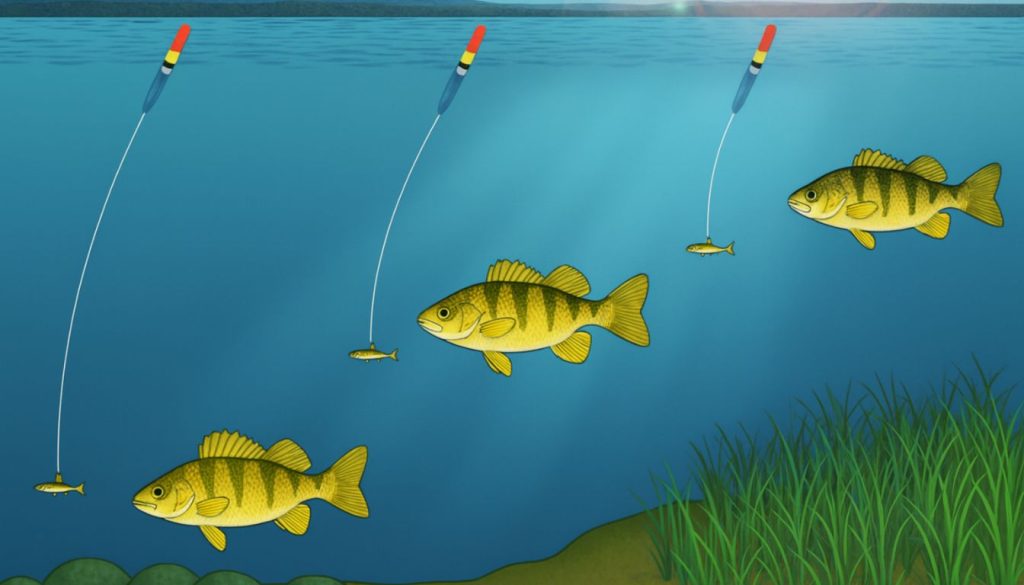
Alternate Technique (Drifting/Trolling): In larger lakes or rivers, drifting or slow trolling a rigged minnow or inline spinner can cover more water. Use a downrigger or heavy sinker to reach depth, then troll 1–2 mph along drop-offs. Another variation is ice fishing: cut a hole on a known deep perch spot and vertically jig a tiny spoon or marabou jig with a waxworm. Patience is key: perch often nibble gently.
Pro Tips: Keep gear light and sensitive – even a bit of slack line can let a perch spit the hook. Use a gentle hookset; perch mouths are soft and “jerking” may pull the hook out. Drop your line slack for a moment if you see the bobber twitch, then set. Watch the rod tip at all times: perch often hit on the drop or subtle movement. Between casts, maintain a tight line so you feel every nibble. When fighting a perch, raise your rod high (10–11 o’clock) to keep tension and reel steadily. Finally, always carry needle-nose pliers: perch have sharp gill covers and dorsal spines, so handle with care when unhooking.
Catch and Handling
During the Fight
Yellow perch put up a light but spirited fight on light tackle. Once hooked, perch will typically make short darting runs or head shakes. Keep steady pressure and a high rod tip to avoid slack.
Because perch are relatively small, a strong hookset can rip out – it’s better to set the hook moderately and play the fish. Let the drag do some work if needed. Avoid “horseplay” with the fish to prevent snapping the line on snags or tearing the soft mouth.
Common mistakes include lifting the rod too quickly (letting the hook tear out) or paying out too much line (losing contact). Keep your movements smooth and controlled. If a hooked perch jumps, lower your rod slightly to cushion the motion.
Catch and Release
Perch generally survive well when released properly. Use a rubberized landing net or wet hands to support the fish and minimize slime removal. Carefully remove the hook; using pliers or hemostats helps safely unhook barbless or pinched-barb hooks. Avoid handling the fish by the gill plates or spines.
Hold the perch gently in the water, supporting its belly, and allow it to swim away once it revives. If the perch is bleeding from a deep hook, leave the hook and cut the line close to the mouth – the wound will heal.
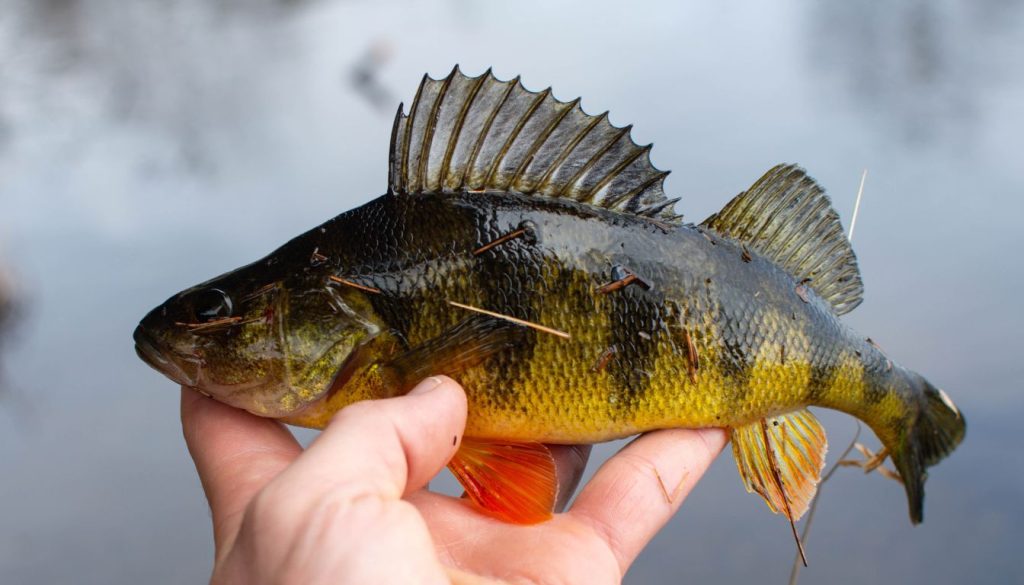
Quick handling and a wet hold maximize survival. In cooler water (below 60°F) perch recover fastest; in warmer water, try to return them promptly to reduce stress.
For Consumption
Yellow perch are often kept as excellent table fare. If you plan to keep fish, dispatch quickly and humanely. A sharp blow to the head or a quick “ike jime” (brain spike) immediately behind the eyes will kill the perch instantly. Another method is to cut the spinal cord or sharply pierce the brain.
Bleed the fish by slicing the gill arches or tail artery before placing it on ice. Then gut and clean the perch as soon as possible. To preserve quality, fillet the fish promptly and store the fillets on ice or in the refrigerator.
Chilling the fish immediately after capture prevents the fine-textured flesh from spoiling. Cook perch soon after catching; their delicate white flesh is best enjoyed fresh with simple seasoning. Proper handling from water to plate will ensure your catch remains firm, flaky, and mild-tasting.
Sources: Authoritative fisheries guides and state resources on yellow perch biology and angling
